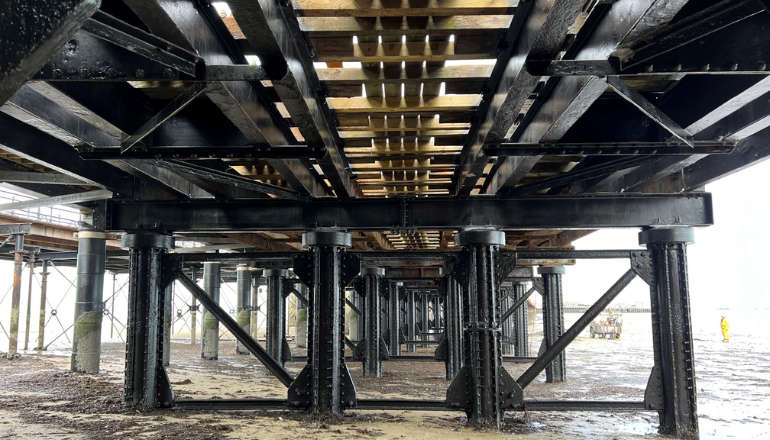
The owners of a holiday cottage in Bonchurch believe they’ve uncovered the inspiration behind the infamous Charles Dickens character, Miss Havisham.
The jilted bride was left at the altar in the iconic 1861 novel, Great Expectations, spending the rest of her life in solitude, dressed in a dusty old wedding gown.
Now it’s been revealed Bonchurch resident, Margaret Dick, suffered a strikingly similar fate, cutting herself off from society after being jilted at the altar in 1860 – while Dickens was writing his novel.
According to a guide of Bonchurch discovered by Alan Cartwright of Haviland Cottage, Dickens dined with Margaret Dick during his many stays in Bonchurch and Ventnor between 1838 and 1860.
Alan has been researching the local history since he took over the holiday cottage three years ago, with help from Ventnor Heritage Centre, Bonchurch Community Association, members of the Charles Dickens Fellowship, and others.
Alan said:
“In 1849, the author Charles Dickens moved to Bonchurch, Isle of Wight for a long summer. During this time, he enjoyed walking around Bonchurch village, Ventnor and the surrounding areas.
“He also got to know many people in the local community which influenced his writing. In fact, a few of these local characters found their way into some of his most celebrated literary works which have become some of the world’s favourite books David Copperfield (published 1850) and Great Expectations (published 1860).”
You’ll see key locations which influenced Dickens' literary works marked by a blue plaque around the village of Bonchurch and in Ventnor.

Winterbourne, where Charles Dickens stayed while on the Isle of Wight
Haviland Cottage itself is believed to have played a part in inspiring the story, with the name of its previous owner ‘Miss Haviland’ bearing a resemblance to the name used in the novel.
Ian Dickens, great-great-grandson of the iconic author and president of the Dickens Fellowship agreed with the findings:
“She was certainly an important inspiration.
“As an artist, you take elements from lots of people. But because they were friends it's too big a coincidence not to think that she influenced it.”
Margaret wasn’t the only member of the Dick family to inspire Dickens’ work. A character named Mr Dick also appears in David Copperfield, Dickens’ 1849 novel, which was written during his stay at Winterbourne Country House in Bonchurch.
Dickens was said to have enjoyed many walks with Margaret’s brother, Charles George Dick.

Alan Cartwright said:
“We discovered that two of his characters, Mr Dick and Miss Havisham, were based on villagers who were actually brother and sister.
“I'm absolutely certain that Mr Dick was named after his walking companion and I'm pretty certain that Margaret Dick inspired Miss Havisham.
“It's one coincidence too many — she knew him, was jilted, and the fact that it was all written in about 1860 when Miss Dick was left at the altar.
“And Havisham and Haviland is such a close switch, he often played around with names. Margaret Dick lived an isolated life but we have concluded that it must have been her.
“The discovery has been wonderful for me, for someone who is not a historian.”

Uppermount, where Charles Dickens dined with the Dick family.
After being jilted at the altar, it is reported Margaret Dick retired to Ventnor's nearby Madeira Hall, where she lived out her years in the loft, while food was taken up to her through a trap door.
The BBC has recently announced a new adaptation of Great Expectations, with Olivia Colman cast as Miss Havisham. Release date still to be announced.
To read more of the research uncovered by Alan Cartwright and the team at Haviland Cottage, visit www.havilandcottage.com/dickens

 Red Funnel Technical Issues Continue With Several Crossings Cancelled
Red Funnel Technical Issues Continue With Several Crossings Cancelled
 Summer Reading Challenge Set To Fire Children's Imaginations
Summer Reading Challenge Set To Fire Children's Imaginations
 Community Fund Boost For Innovative School Library Bus Project
Community Fund Boost For Innovative School Library Bus Project
 Eric Takes To The Skies To Fulfil Dream Aged 92
Eric Takes To The Skies To Fulfil Dream Aged 92
 Vecta House Care Home Classic Car Show A Roaring Success
Vecta House Care Home Classic Car Show A Roaring Success
 Painting Prize For Ryde Pier Refurbishment
Painting Prize For Ryde Pier Refurbishment
 Red Funnel And Isle Of Wight Foodbank Announce ‘Can Drive For Cowes Week’
Red Funnel And Isle Of Wight Foodbank Announce ‘Can Drive For Cowes Week’
 Access For All At Ryde Harbour Beach As New Facilities Officially Opened
Access For All At Ryde Harbour Beach As New Facilities Officially Opened
 Isle Of Wight Council Computers Find New Home Via Schools In Africa
Isle Of Wight Council Computers Find New Home Via Schools In Africa
 Garwin Announced As Official Weather Sponsor For Cowes Week
Garwin Announced As Official Weather Sponsor For Cowes Week
 Isle Of Wight Steam Railway Names First Chief Executive
Isle Of Wight Steam Railway Names First Chief Executive
 Dentistry Focus For Island MP Joe's First House Of Commons Speech
Dentistry Focus For Island MP Joe's First House Of Commons Speech
 Swimmer Saved By Heroic Efforts Of 1Leisure Staff
Swimmer Saved By Heroic Efforts Of 1Leisure Staff
 Food On The Move Initiative Receives £20,000 Grant To Support Islanders
Food On The Move Initiative Receives £20,000 Grant To Support Islanders
 New Deck Set For Yarmouth Bridge
New Deck Set For Yarmouth Bridge
 Cowes Students Deliver Enterprising Ideas
Cowes Students Deliver Enterprising Ideas
 World War II Spitfire Makes Unplanned Touchdown At Sandown Airport
World War II Spitfire Makes Unplanned Touchdown At Sandown Airport
 Hampshire And Isle Of Wight Wildlife Trust Launches Business Pledge
Hampshire And Isle Of Wight Wildlife Trust Launches Business Pledge
 Jet Skier First Cautioned Under New Safety Law After Isle Of Wight Ferry Incident
Jet Skier First Cautioned Under New Safety Law After Isle Of Wight Ferry Incident
 New Lease Of Life For St Mary's Children's Ward
New Lease Of Life For St Mary's Children's Ward


